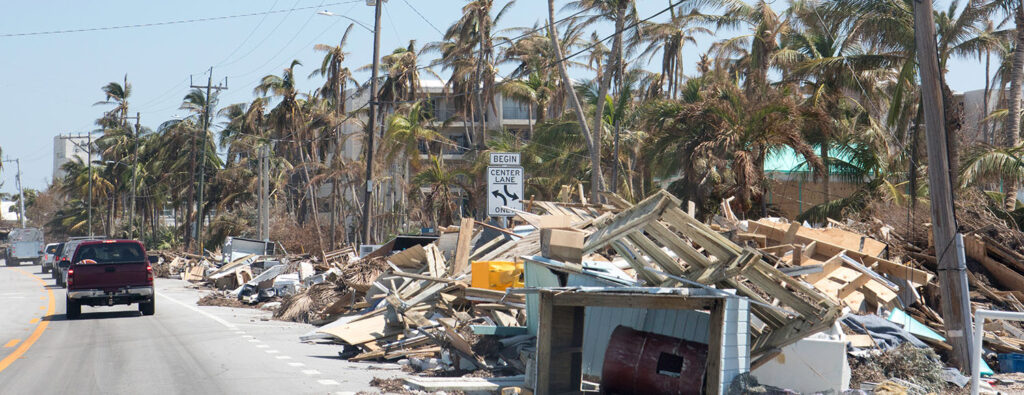The Federal Emergency Management Agency (FEMA) is authorized to provide Public Assistance (PA) funding for emergency work, including debris removal, following a Presidentially declared disaster. Debris removal is an essential part of disaster recovery, as it helps to eliminate immediate threats to lives, public health, and safety, as well as protect improved public or private property. For the removal of debris to be eligible, the work must, at a minimum:
· Be required as a result of the declared incident; and
· Be located within the designated area; and
· Be the legal responsibility of an eligible Applicant.
Additional requirements are necessary for specific debris types to be eligible for removal, which require specific documentation practices.
While eligibility and documentation requirements can seem straightforward, the process of debris removal can be complex and nuanced, particularly when it comes to compliance with Environmental and Historic Preservation (EHP) laws. Different states have different laws, regulations, and Executive Orders that govern EHP which impacts debris removal planning and operations, but there are also federal laws that each state must follow. It is important for local governments and their recovery partners to be aware of these requirements when planning and implementing debris removal operations.
One example of a federal act that can impact debris removal planning and operations is the Clean Air Act, which establishes national air quality standards and regulates the emission of pollutants from various sources. In order to comply with the Clean Air Act, local governments may need to obtain permits for certain types of debris removal activities, such as reducing debris by burning or shredding, or using specialized equipment to minimize air pollution. For example, prior to recycling refrigeration and climate control appliances, freon and other refrigerants should be properly removed to prevent harmful contaminants from leaking into the environment. By following all applicable regulations and working closely with federal and state agencies, local governments can help to protect the air quality of their communities and neighboring communities while effectively and efficiently responding to and recovering from a debris-generating event.
Another example is the Clean Water Act, which regulates the discharge of pollutants into the nation’s surface and ground waters. Local governments may need to obtain permits or follow specific guidelines when removing debris from waterways or wetlands in order to comply with the Clean Water Act. Additionally, local governments on state borders must ensure that any debris removal activities they conduct within waterways do not contaminate navigable water sources that flow across state lines, this is known as the “Antipollution Provision”.
Proper precautions should be taken when planning a temporary debris management site that will stage Construction and Demolition debris (C&D), Household Hazardous Waste (HHW), Electronics, and Appliances to minimize leaching of heavy metals and other contaminants into the soil, which could pose a threat to ground waters, humans, and the efficacy of growing vegetation. Proper soil sampling at the onset of an operation and after remediation is recommended to ensure soil contaminants are within the same levels as sampling done during pre-site inspections, or soil remediation is necessary.
The Endangered Species Act is another federal act that can impact debris removal operations, as it protects threatened and endangered species and their habitats. Local governments may need to coordinate with federal or state agencies to ensure that debris removal activities do not impact these species or their habitats. This could impact debris removal planning if the debris removal site is located in or near the habitat of a protected species, as special measures may need to be taken to avoid disturbing or harming the species in question. While many may think of animal wildlife when it comes to endangered species, this also includes endangered plant species. In one scenario a few years ago, we were tasked with debris removal management and monitoring along a stretch of highway during nesting season of an endangered species of sea turtle where hatchlings would cross the highway to reach water. It became our responsibility to provide environmental monitoring that stopped any debris removal operations during nesting season when a hatchling crossing the highway was threatened by the debris removal operation.
In addition to federal laws, local governments must also be aware of state laws, regulations, and Executive Orders that may impact debris removal operations. For example, some states have specific regulations regarding the handling and disposal of household hazardous waste, such as pesticides, batteries, and paint, while others may have stricter requirements for the management and disposal of construction and demolition debris. It is important for local governments to be aware of these requirements and to work closely with state agencies to ensure compliance.
Local governments may also need to comply with state historic preservation laws, which protect historic properties and cultural resources. Local governments may need to coordinate with state or federal agencies to ensure that debris removal activities do not impact historic properties or underwater archaeological resources. Special consideration may be necessary when working in areas of known historic interests, for instance, battlegrounds, or where cultural locations are present, such as Native American ritual or burial grounds. In these instances, it may be necessary to have archeological or tribal monitors present to identify and properly secure any historical or cultural artifacts that may be unearthed during the debris removal process. This is of particular importance when working in areas where the ground may not have been fully disturbed previously.
In summary, the process of debris removal following a disaster can be complex and nuanced, and it is important for local governments and their recovery partners to be aware of the various federal and state regulations that may impact their operations. By working closely with federal and state agencies to understand the applicable EHP laws that govern their location, local governments and their partners can ensure that their debris removal efforts are in compliance with all relevant laws and regulations, protect the health and safety of their communities and the environment, and help to ensure a successful and effective debris removal process to pave the way for a swift and comprehensive recovery following a disaster.



